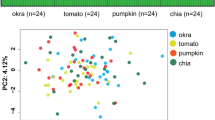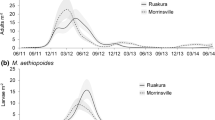Abstract
Weed biocontrol relies on host specificity testing, usually carried out under quarantine conditions to predict the future host range of candidate control agents. The predictive power of host testing can be scrutinised directly with Aconophora compressa, previously released against the weed Lantana camara L. (lantana) because its ecology in its new range (Australia) is known and includes the unanticipated use of several host species. Glasshouse based predictions of field host use from experiments designed a posteriori can therefore be compared against known field host use. Adult survival, reproductive output and egg maturation were quantified. Adult survival did not differ statistically across the four verbenaceous hosts used in Australia. Oviposition was significantly highest on fiddlewood (Citharexylum spinosum L.), followed by lantana, on which oviposition was significantly higher than on two varieties of Duranta erecta (“geisha girl” and “Sheena’s gold”; all Verbenaceae). Oviposition rates across Duranta varieties were not significantly different from each other but were significantly higher than on the two non-verbenaceous hosts (Jacaranda mimosifolia D. Don: Bignoneaceae (jacaranda) and Myoporum acuminatum R. Br.: Myoporaceae (Myoporum)). Production of adult A. compressa was modelled across the hosts tested. The only major discrepancy between model output and their relative abundance across hosts in the field was that densities on lantana in the field were much lower than predicted by the model. The adults may, therefore, not locate lantana under field conditions and/or adults may find lantana but leave after laying relatively few eggs. Fiddlewood is the only primary host plant of A. compressa in Australia, whereas lantana and the others are used secondarily or incidentally. The distinction between primary, secondary and incidental hosts of a herbivore species helps to predict the intensity and regularity of host use by that herbivore. Populations of the primary host plants of a released biological control agent are most likely to be consistently impacted by the herbivore, whereas secondary and incidental host plant species are unlikely to be impacted consistently. As a consequence, potential biocontrol agents should be released only against hosts to which they have been shown to be primarily adapted.


Similar content being viewed by others
References
Barton Browne L, Withers TM (2002) Time-dependent changes in the host-acceptance threshold of insects: implications for host specificity testing of candidate biological control agents. Biocontrol Sci Technol 12:677–693
Dhileepan K, Trevino M, Raghu S (2006) Temporal patterns in incidence and abundance of Aconophora compressa (Hemiptera: Membracidae), a biological control agent for Lantana camara, on target and nontarget plants. Environ Entomol 35:1001–1012
Maher PE, Davis BJ, Day MD, Mackey AP, Palmer WA, Snow EL (2004) What happens when a biocontrol agent attacks exotic but desired ornamentals? In: Sindel BM, Johnson SB (eds) 14th Australian Weeds Conference, Weed Society of New South Wales Inc., Sydney, Charles Sturt University, Wagga Wagga, pp 187–189
Manners AG, Walter GH (2009) Multiple host use by a sap-sucking membracid: population consequences of nymphal development on primary and secondary host plants species. Arthropod-Plant Interact 3:87–98
Marohasy J (1998) The design and interpretation of host-specificity tests for weed biological control with particular reference to insect behaviour. Biocontrol News Inf 19:13N–20N
McFadyen REC (1998) Biological control of weeds. Annu Rev Entomol 43:369–393
McFadyen RE, Day MD, Palmer WA (2003) Putting a price on exotic ornamentals. Biocontrol News Inf 24:48N–49N
Milne M, Walter GH (2000) Feeding and breeding across host plants within a locality by the widespread thrips Frankliniella schultzei, and the invasive potential of polyphagous herbivores. Divers Distrib 6:243–257
Palmer WA (2004) Risk analyses of recent cases of non-target attack by potential biocontrol agents in Queensland. Proceedings of the XI international symposium on biological control of weeds, Canberra, 27 April 2 May, 2003:305–309
Palmer WA, Wilson BW, Pullen KR (1996) The host range of Aconophora compressa Walker (Homoptera: Membracidae): a potential biological control agent for Lantana camara L. (Verbenaceae). Proc Entomol Soc Wash 98:617–624
Pinheiro JC, Bates DM (2000) Mixed-effects models in S and S-plus. Springer, New York
Raghu S, Dhileepan K, Scanlan JC (2007) Predicting risk and benefit a priori in biological control of invasive plant species: a systems modelling approach. Ecol Model 208:247–262
Rajapakse CNK, Walter GH (2007) Polyphagy and primary host plants: oviposition preference versus larval performance in the lepidopteran pest Helicoverpa armigera. Arthropod-Plant Interact 1:17–26
Rajapakse CNK, Walter GH, Moore CJ, Hull CD, Cribb BW (2006) Host recognition by a polyphagous lepidopteran (Helicoverpa armigera): primary host plants, host produced volatiles and neurosensory stimulation. Physiol Entomol 31:270–277
Schoonhoven M, Jermy T, van Loon JJA (1998) Insect-plant biology. Chapman & Hall, London
Sheppard AW, van Klinken RD, Heard TA (2005) Scientific advances in the analysis of direct risks of weed biological control agents to nontarget plants. Biol Control 35:215–226
Tableman M, Kim JS (2004) Survival analysis using s: analysis of time-to-event data. Chapman & Hall/CRC, Boca Raton
van Klinken RD (2000a) Host-specificity constrains evolutionary host change in the psyllid Prosopidopsylla flava. Ecol Entomol 25:413–422
van Klinken RD (2000b) Host specificity testing: why do we do it and how we can do it better. In: van Driesche R, Heard TA, McClay AS (eds) Making exotic species introductions safer: testing biological control agents in view of behaviour and evolution. USDA Forest Service, Morgantown, pp 54–68
van Klinken RD, Heard TA (2000) Estimating fundamental host range: a host-specificity study of a potential biocontrol agent for Prosopis species (Leguminosae). Biocontrol Sci Technol 10:331–342
Walter GH (2003) Insect pest management and ecological research. Cambridge University Press, United Kingdom
Walter GH, Benfield MD (1994) Temporal host plant use in three polyphagous Heliothinae, with special reference to Helicoverpa punctigera (Wallengren) (Noctuidae: Lepidoptera). Aust J Ecol 19:458–465
Wheeler GS (2005) Maintenance of a narrow host range by Oxyops vitiosa; a biological control agent of Melaleuca quinquenervia. Biochem Syst Ecol 33:365–383
Zalucki MP, Day MD, Playford J (2007) Will biological control of Lantana camara ever succeed? patterns, processes & prospects. Biol Control 42:251–261
Acknowledgments
Thanks to Alan Fletcher Research Station for glasshouse space to conduct these experiments and Wallum Nurseries Pty Ltd for providing plants that were otherwise unavailable. Thanks to Jayd McCarthy, Noel Wakerley, Patrick Rogers, John Adler and Gio Fichera for providing assistance over the course of experiments. Thanks to Raghu, Walter Carson, Rieks van Klinken, Rachel McFadyen and Dane Panetta who provided helpful comments on previous drafts of this paper. This research was funded by a PhD scholarship from the CRC for Australian Weed Management.
Author information
Authors and Affiliations
Corresponding author
Additional information
Handling Editor: Walter Carson.
Rights and permissions
About this article
Cite this article
Manners, A.G., Palmer, W.A., Dhileepan, K. et al. Characterising insect plant host relationships facilitates understanding multiple host use. Arthropod-Plant Interactions 4, 7–17 (2010). https://doi.org/10.1007/s11829-009-9079-2
Received:
Accepted:
Published:
Issue Date:
DOI: https://doi.org/10.1007/s11829-009-9079-2




